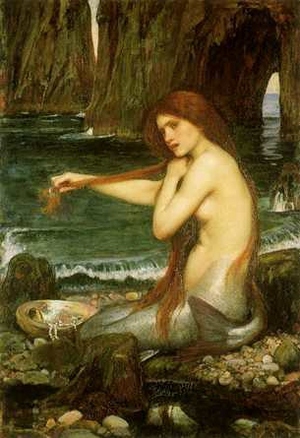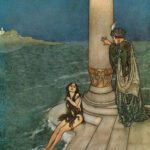Mankind has been intrigued with the idea of mermaids for centuries; as far back as 5000 B.C. These mythical creatures which are said to be half-human and half fish have been the subject of great literature, beautiful music, and entertaining film. They adorn many statues and were the subject of sculptures and paintings.
Few mythical creatures have managed to insinuate themselves into different cultures around the world. Yet virtually every continent as a storehouse of mermaid myths and legends. What is it about these creatures that so captivates us? Let’s explore and see if we can find an answer.
Mermaids are most often pictured as females but the male of the species – – merman – – isn’t entirely absent from folklore. These creatures, which have the torso of a human and the tail of a fish, are often believed to bring good luck. However, in some cultures, the sighting of a mermaid is viewed as a curse.
Although many people believe that the concept of mermaids originated with Greek mythology, others insist that their legend began much earlier than that. The Greeks, however, may have borrowed some characteristics of the mermaid myth. The Sirens of Greek mythology supposedly had the ability to sing so beautifully that they can lure sailors to their death.
Stories of mermaids were often polar opposite. In some cultures, they were thought to despise mankind, particularly the male of the species. These creatures would take any opportunity to do away with their enemies. Like the myths that the Greeks portrayed, these mermaids sought to lure sailors to their death, drowning them out of pure spite.
Other legends believe that mermaids were the keepers of the ocean, constantly vigilant in their duty to rescue mankind from accidents at sea. Unfortunately, their rescues sometimes went wrong, ending with them squeezing the life out of their victims during rescue attempts.
Still other stories have mermaids enchanted by mankind; so much so in fact, that they often fell in love with the human males that they had rescued. But attempts to take their victims home to the depths of the sea always failed since human beings cannot breath under water.
Although myths about mermaids exist in many cultures, they differ greatly from country to country. Let’s take a look at the various mermaid incarnations.
An African legend tells the tale of Mami Wata. She was believed to be a powerful water spirit with the ability to heal the sick. Benevolent most the time, Mami Wata had a violent temper most often exposed when her followers refused to obey her commands. For revenge she would make them sick, both mentally and physically.
More than 20 African countries still have followers of Mami Wata. She is most often depicted with long straight hair, which is sometimes black and other times green. A snake encircles her as a symbol of her power.
In many areas of the world, there exists a group of followers for the mermaid Lasiren. She too has long, straight hair and carries a mirror and comb. Lasiren, it is said, lives between two worlds; the world of humanity and her own which is called “the back of the mirror.” The mirror she carries is a symbol of the boundary between the earthly realm and her own.
Canada’s mermaid legend involves a once human woman who was thrown into the sea by her father. But she did not perish. Instead the creatures of the deep came to her rescue her and gave her gifts that would allow her to breathe underwater.
The mermaid, who is called Sedna, vowed revenge not only on her father but on every sailor who didn’t come to her rescue. Supposedly her anger drove her insane causing her to equate all sailors with those that abandoned her to the dark waters. Some believe that she also avenges those who have been betrayed like herself.
Taleeajuq is pictured as a mermaid with child. Her myth indicates a gentle, loving figure that was a friend to mankind. She is revered by several different cultures.
The Aborigines of Australia worshipped the spirits that they credited with making the land, trees, and animals. Yawkyawk, one of these spirits, looked like a mermaid. They believed that at night, the mermaid could grow legs and roam the earth. They also believed that she could take on other forms; the favorite of which was a dragonfly because it gave her the power of flight.
Yakyawk was also had the special, life-giving powers. For example, any woman who drank from her watering hole would immediately become pregnant. She had the power to control water; bringing rain to allow plants to flourish. But she could also bring storms on the ocean when she became angry.
There are many English and American tales of mermaids. Pocahontas claimed to have spotted one along America’s coast. The English explorer Henry Hudson wrote of his encounter with a mermaid.
Sightings of mermaids have been reported all around the world. Some were easily proven to be false, while others have left men wondering if they truly did – – or do exist. Hans Christian Anderson believed so and made them the subject of one of his most popular stories. Even a picture from the Nuremberg Bible seems to indicate that mermaids may have, indeed, existed.
However, there have also been many hoaxes perpetrated in their name. P.T. Barnum once claimed to have discovered the skeletal remains of a mermaid. For years, his Feejee Mermaid tricked thousands of people who wanted to believe.
Many others have attempted various hoaxes over the years. In 2005, photographs were doctored to try and prove their existence. They were circulated via the Internet, reaching hundreds of thousands of people; many of who choose to believe in the existence of these water sprites.
I doubt the existence, or even the non-existence, of these beings will ever be known for sure. Perhaps it doesn’t matter one way or the other. Certainly the stories that involve them will continue for generations to come, touching the hearts and souls of those who believe in infinite possibilities.



